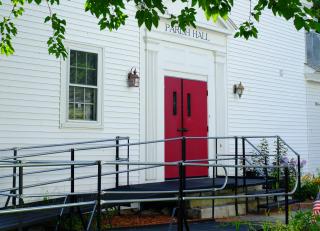Advertisement
A new certification program to help congregations become more inclusive and accessible to people living with disabilities, the Accessibility and Inclusion Ministry Program (AIM), has been formally launched by the Unitarian Universalist Association and EqUUal Access, an advocacy and support group for UUs living with disabilities. (See “Changing Ideas about Disabilities.”)
First UU Congregation of Ann Arbor, Michigan, was the first congregation to be AIM-certified, at General Assembly 2016. Twelve other congregations are in the process, said Michelle Avery Ferguson, part-time AIM administrator.
Rather than simply encouraging congregations to make tangible changes like adding wheelchair ramps, AIM also seeks to effect widespread change in attitudes about an often-overlooked social justice issue. “What’s really at the heart of the program is getting people to be more aware of attitudes about disability and shifting them,” said Suzanne Fast, president of EqUUal Access.
AIM is modeled on the UUA’s Welcoming Congregation program, in which congregations can be certified as being welcoming to the LGBTQ community, and the Green Sanctuary program, in which congregations can be certified for commitment to environmental justice.
The AIM application guides congregations through a detailed self-assessment around accessibility and inclusion related to disabilities. With the guidance of an AIM team, a congregation creates a plan for more fully integrating people with a wide range of disabilities, including mobility difficulties, mental health issues, developmental delays among children, and more. Accessibility refers to such things as whether hymnals are available in large print for people with vision problems. Inclusion refers to how well people with disabilities are welcomed and included in worship services and other aspects of congregational life.
Each congregation sets its own pace for obtaining certification, a process that’s expected to take several years.
The Ann Arbor congregation began a major cultural shift when it embarked on the AIM certification process three years ago, said Els R. Nieuwenhuijsen, a disability expert who has been involved in the AIM team from the start. People now feel more comfortable discussing their own disabilities, she said, including several teens who did a presentation on their experiences with ADHD. “Inclusion is about educating people and people getting more awareness, and it’s an ongoing process,” she said. They’ve added handrails in the women’s bathroom and trained greeters on appropriate ways to interact with people with disabilities, and have plans for more as resources become available.
“As congregations engage in this work, I hope they see themselves as involved in a social justice issue in which they can make a difference in the world,” said Michael Sallwasser, a former UUA trustee who was on the AIM design team. His congregation, the UU Church of Long Beach, California, is in the process of AIM certification.
Corrections
The print edition version of this article identified Michael Salwasser as a member of the UUA Board of Trustees. His term ended in June 2016.
